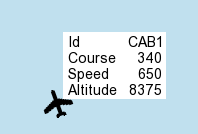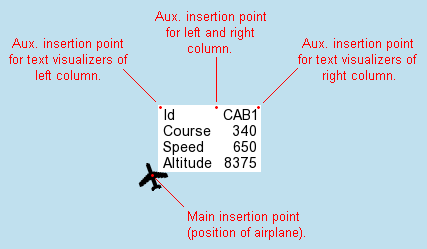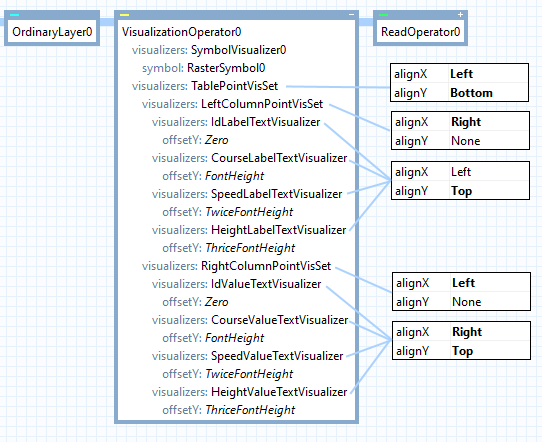PointVisualizerSet Class
A visualizer that combines several other point visualizer into a single unit.
NuGet/Assembly: Carmenta.Engine.5.17.0.nupkg (in the CECore assembly)
Syntax
public class PointVisualizerSet : PointVisualizerRemarks
There is a map configuration sample point_visualizer_set.px that shows how to make a label with two columns using a PointVisualizerSet.
A PointVisualizerSet is a collection of point visualizers, similar to a VisualizerSet. The relative positions of these point visualizers are computed with reference to an auxiliary insertion point. Once their relative positions are fixed, the entire group will act as a single point visualizer, and can be offset, rotated, scaled etc, the same way as an ordinary symbol or text visualizer. It can also be moved around as a single object by a LabelOrganizingLayer. See below for an example.
A PointVisualizerSet can be applied to point, line and polygon features; all other feature types are ignored.
Like a text visualizer, the PointVisualizerSet supports a background box: a filled and/or outlined rectangle drawn behind the contained visualizers. The size and position of the box is calculated to fit the presentation of the contained visualizers, with an optional padding. Also like a text visualizer, the presentation may be aligned horizontally and vertically to either side or the center of the group.
The Visualizers property holds the list of visualizers in the PointVisualizerSet. The list may contain text and symbol visualizers, and also other PointVisualizerSet instances. The PointVisualizerSet changes the behavior of these visualizers in several ways:
Properties that only make sense for the whole group and not the individual visualizers are ignored. These include At, AtCenter, LabelOrganizingSettings, LeadLine, LeadLineSettings, Repeat and ClipToViewArea.
The scale factor of the PointVisualizerSet is propagated down and multiplied to the scale factors of the individual visualizers. This means that the entire PointVisualizerSet can be scaled up or down by specifying a scale factor for the PointVisualizerSet.
The horizontal (or vertical) position of the combined presentation will normally depend on the alignment and offset properties of the individual text and symbol visualizers, and on the offset properties of the PointVisualizerSet. However, it is possible to align the combined presentation as a whole, by setting the AlignX and AlignY properties of the PointVisualizerSet to appropriate values.
The LengthUnit properties of the individual visualizers are ignored; the value from the PointVisualizerSet is used for all the visualizers.
The properties that control rotation still work for the individual visualizers. However, some rotation modes would normally say that the up direction is a segment direction of a line feature or polygon feature; when these modes are used for the parts of a PointVisualizerSet, the direction of the PointVisualizerSet will be used instead of a segment direction. (See Rotation for more details). The best design is usually to set RotationMode = Rotated and Rotation = 0.0 on all parts and subparts, and use a different rotation mode and rotation (if needed) only on the root PointVisualizerSet. With this design, the entire visualization can be rotated as a rigid chunk.
Example: Two-column table
Here is an example, where we want a label to contain a table with two columns.
 |
We wanted the left hand column to be left-aligned, but the right hand column to be right-aligned since it contains numbers. The table above was achieved via a main PointVisualizerSet, consisting of two parts, one for the left column and one for the right, each part also being a PointVisualizerSet. Each part consists of four text visualizers.
We have used the ability to realign a PointVisualizerSet independently from the alignment of its parts. With this approach, the auxiliary insertion point for the parts will only control their relative placements, and can be forgotten when the entire chunk of text is realigned to a higher-level insertion point.
 |
So, the left column above was created by a PointVisualizerSet that used the upper left corner as its auxiliary insertion point. Its four text visualizers have alignX = Left and alignY = Top; their vertical placements come from their having offsetY of 0, 16, 32 and 48 pixels, which works fine since the font size is fixed at 14 pixels.
In a similar way, the right column above was created by a PointVisualizerSet that used the upper right corner as its auxiliary insertion point. Its four text visualizers have alignX = Right and alignY = Top, with their vertical placement implemented in the same way as the left column.
Then, the two columns must be placed relative to each other. So the two PointVisualizerSet instances for the columns are used as components in a top-level PointVisualizerSet. The entire left hand column is now right-aligned and the entire right hand column is left-aligned, relative to a new auxiliary insertion point between the columns.
Finally, the entire table, created by the top-level PointVisualizerSet, can be left-aligned and bottom-aligned relative to the airplane position.
The configuration looks like this:
 |
A similar example can be found in the configuration sample point_visualizer_set.px.
Inheritance Hierarchy
System.Object
EngineObject
ResourceObject
Visualizer
PointVisualizer
PointVisualizerSet
Platforms
Windows, Linux, Android
PointVisualizerSet Members
The PointVisualizerSet type has the following members.
Constructors
| Name | Description |
|---|---|
| PointVisualizerSet | Initializes a new instance of the PointVisualizerSet class. |
Properties
| Name | Description |
|---|---|
| AlignX | Gets or sets a value specifying how the combined presentation is aligned horizontally. |
| AlignY | Gets or sets a value specifying how the combined presentation is aligned vertically. |
| AntiAlias | Gets or sets a flag indicating if antialiasing should be used to remove aliasing artifacts by smoothing the pixels. Inherited from PointVisualizer |
| At | Gets or sets a value that determines the placement of an object along lines. Inherited from PointVisualizer |
| AtCenter | Gets or sets a value indicating if the PointVisualizerSet is applied to the center of a polygon feature, or along the edge. Inherited from PointVisualizer |
| AzimuthRotation | Gets or sets a value indicating whether the Rotation angle starts from true north. Inherited from PointVisualizer |
| BackgroundColor | Gets or sets the color to use for the background box. |
| BackgroundOutlineColor | Gets or sets the color to use for the outline of the background box. |
| BackgroundOutlineWidth | Gets or sets the width of the background box outline. |
| BackgroundPadding | Gets or sets a value specifying how much extra space should be added between the presentation and the edges of the background box. |
| CacheAsBitmap | Gets or sets a value that determines whether the symbol is cached as a bitmap. |
| ClipToViewArea | Gets or sets a value indicating if the feature should be clipped to the visible view area before the visualizer is applied. Inherited from PointVisualizer |
| Color | Gets or sets the color used to draw the features. Inherited from PointVisualizer |
| Condition | Gets or sets a condition that must evaluate to true if the visualizer shall be applied to a feature. Inherited from Visualizer |
| IsDisposed | Gets a value that tells whether the current PointVisualizerSet has been disposed. Inherited from EngineObject |
| LabelOrganizingSettings | Gets or sets the settings that control how the rendering will be affected by a LabelOrganizingLayer. Inherited from PointVisualizer |
| LeadLine | Gets or sets a value indicating if a lead line should be drawn for offset objects. Inherited from PointVisualizer |
| LeadLineSettings | Gets or sets properties controlling how lead lines are drawn. Inherited from PointVisualizer |
| LengthUnit | Gets or sets a value defining the length unit of some other properties. Inherited from PointVisualizer |
| Name | Gets or sets the name of the PointVisualizerSet. Inherited from ResourceObject |
| NativeHandle | Gets the native Carmenta Engine kernel object the current PointVisualizerSet represents. Inherited from EngineObject |
| OffsetX | Gets or sets a value offsetting the visualization of an object from its geographic position. Inherited from PointVisualizer |
| OffsetY | Gets or sets a value offsetting the visualization of an object from its geographic position. Inherited from PointVisualizer |
| OffsetZ | Gets or sets a value offsetting the visualization of an object from its geographic position. Inherited from PointVisualizer |
| Opacity | Gets or sets a value that specifies the opacity of the features. Inherited from PointVisualizer |
| PickingSupport | Gets or sets a value specifying how much information is maintained when the visualizer creates a PresentationObject for a feature. Inherited from Visualizer |
| RenderingPriority | Get or sets how the visualization is prioritized. Inherited from PointVisualizer |
| Repeat | Gets or sets a value determining the placement of an object along lines and polygon edges. Inherited from PointVisualizer |
| RingOrientation | Gets or sets the desired orientation of polygon rings and closed line features. Inherited from PointVisualizer |
| Rotation | Gets or sets a value specifying the direction of the object. Inherited from PointVisualizer |
| RotationMode | Gets or sets a value that indicates how a label or symbol is rotated. Inherited from PointVisualizer |
| Scale | Gets or sets a value controlling the size of the visualization. Inherited from PointVisualizer |
| IUserProperties.UserProperties | Gets the AttributeSet that contains the user properties. Inherited from IUserProperties |
| Visualizers | Gets the list of point visualizers combined by the PointVisualizerSet. |
Methods
| Name | Description |
|---|---|
| Clone | Creates a copy of an object. Inherited from EngineObject |
| Dispose | Releases the reference to the native Carmenta Engine kernel instance the EngineObject represents. Inherited from EngineObject |
| Draw | Draws a feature on a drawable. Inherited from Visualizer |
| Equals | Determines whether this instance is equal to another. Inherited from EngineObject |
| FindChildObject | Overloaded. Finds the child object with the specified name. Inherited from Visualizer |
| GetChildObjects | Overloaded. Gets the child objects of the current object. Inherited from Visualizer |
| GetImage | Renders a feature onto a bitmap and returns it. Inherited from PointVisualizer |